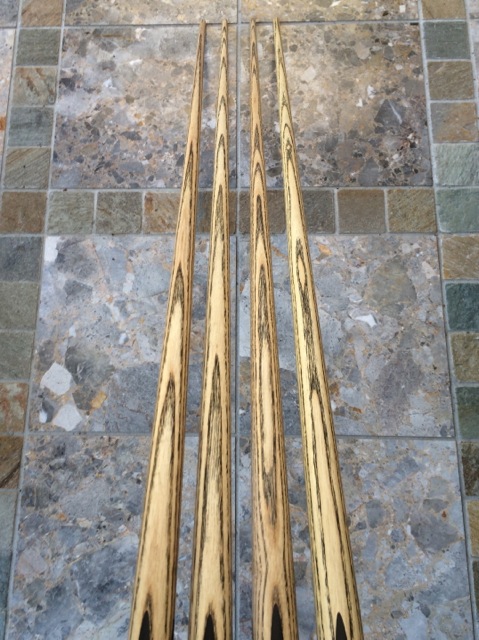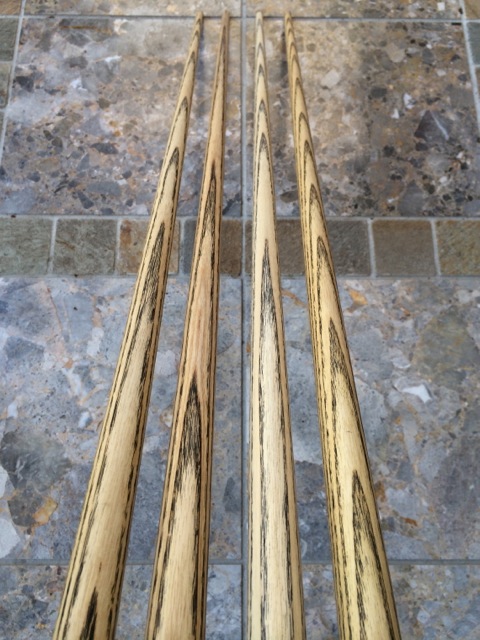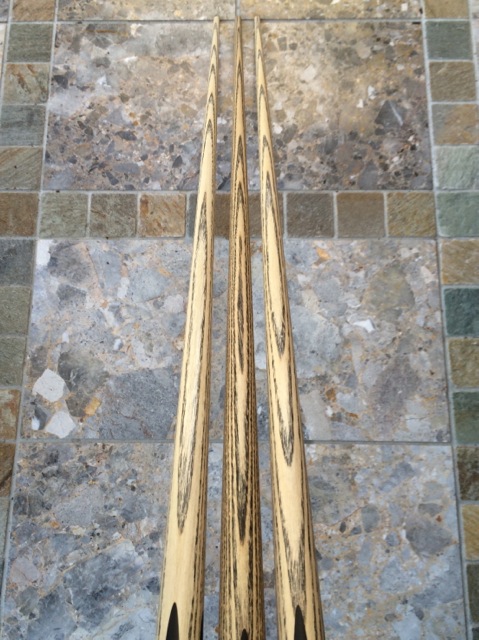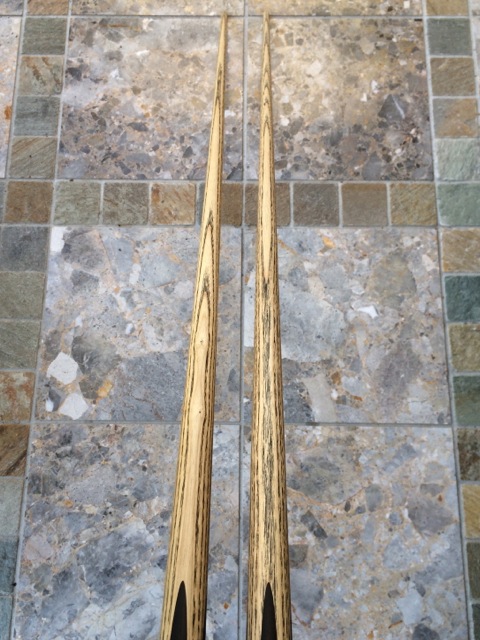Q: Which shaft is best?

A: None. They are all great playing shafts.
All shafts are selected from the same professional playing standard stock so whatever cue you choose, it will play well and have a nice appearance with at least one or two arrows towards the top of the cue.
Below the bridging area, the grain pattern is out of view when playing, so this section of the cue is relatively unimportant when it comes to how good the cue is. However, the two cues on the left have particularly pleasing grain patterns and would be reserved for possible custom cue use.
Who needs a Standard Shaft?
Players. Good players. Or anyone who just wants a good cue.
These are selected with the emphasis being on at least one or two arrows near the top of shaft where you may sight the cue.
Some may have many more arrows, some may have few, some grain may be wide, some may be tight. Either way, the overall quality of the cue will be judged on how good the shaft 'feels'.
Most people are content with a good solid 'playing' cue, and are happy to accept any grain pattern as the 'character' of the cue. This is how it should be, choose a cue that plays well and do not worry too much about what the shaft looks like.
However, some people also crave a very specific shaft grain appearance. This is harder to find, so I grade these premium shafts as 'Deluxe' and reserve them for custom orders.
But be very clear - my standard shafts look fine and are chosen because they play well. Besides, more often than not, they are generally better looking than so-called 'ultimate' shafts on competitors cues.
What can you ask for?
Whilst you cannot specify any grain pattern for a standard cue, you are welcome to give me a general idea of your preferences i.e. stiff, medium, whippy, lots of arrows, not many arrows, tight grain, wide grain, dark 'aged' look, lighter cleaner look etc., etc..
I won't make any promises but I will try to select something I think you will like from any available shafts I have.
Notes on Maple
Maple shafts have hardly any noticeable grain compared to Ash but are still selected with the emphasis placed on playing qualitites. Thereafter, the clearness and straightness of the grain is considered in the case of custom cues.
Who needs a 'Deluxe' Shaft?
Erm...Good question...
Before I explain more, I want to make a very important point about the type of people who usually 'demand' this. More often than not, they are relatively inexperienced with little or no idea what actually constitutes a good cue.
If they're not new to the game, they are usually 16 break players at best, but they simply "must have a shaft with exactly seven perfectly spaced arrows". They have plenty of money to spend (waste) and quite often an attitude to match...
Collectors have a genuine reason for wanting a lovely looking cue shaft in their collection, but good snooker/pool players rarely place so much importance on this requirement.
Don't get me wrong, I fully understand why some people crave visual 'perfection', and I have no problem looking for it nor judge people when they ask. I'm just saying you'll rarely get a good player who pays much attention to what a shaft looks like.
So maybe you should consider that fact before the obsession sets in, that's all I'm saying...
These premium selected shafts are from the exact same professional grade board stock as standard shafts but benefit from the most even of grain patterns.
Finding these most 'perfect' looking shaft is both difficult and time consuming. Much wood must be sorted, cut, shaped, and even then, when it gets close to size, it might look good but 'feel' wrong. So, not only is there a lot of wasted material costs, but an awful lot of time is lost. It's like searching for precious stones - when you find a diamond, it's worth something.
Therefore, any cue with one of my deluxe shafts will command a premium based on time spent and wasted materials. Time is money, and this is the reason why a cue requested with specific grain pattern is more expensive than a standard cue, NOT that it is actually better made or a better playing cue.
Here are some examples of premium shafts, selected for the cleanest and most even grain pattern:

The shafts below have what is known as a 'boat' pattern in the grain, where the grain changes direction, but the overall appearance of the shaft is very clean and even, with really nice arrows towards the top of the shaft:

The last type of premium shafts are the ones with very straight lines at the sides. Not commonly requested but these are suitable for those players who like to sight using the lines at the top of the cue.

You can see here that the grain runs almost perfectly straight over the bridge area right through to the tip but, be warned, shafts that have grain this straight will often have arrows that are maybe not so clear, possibly longer and more grainy in appearance.
Finding nice arrows on the front together with straight lines at the side is not impossible but usually if it has straight lines at the sides then the arrows are likely to be less clear and even.
Save Money!
Shafts that have minor visual flaws usually end up in the corner of the workshop and get sold off cheaper at some point. I call these sin bin cues and they can be found in the N.O.S. section of shop along when available.
They are as good as any with regards to playing qualities, but for one reason or another I may have 'rejected' them because I am not entirely happy with the grain pattern.
This could be any number of minor issues ranging from arrows near the top not quite looking okay to me, a minor blemish somewhere on the shaft, or maybe an area of 'messy' grain.

The cue on the left has a couple of areas with minor knots (knots do not affect a cue's playability) and also some unusual blemishes in the side grain in places, The cue on the right has some nice arrows at the top but a long area of 'messy' grain, albeit low down on the shaft.
To be honest, none of these reasons are good enough to reject a cue because they do not affect it in any way shape or form, and there are plenty of people out there who really do not mind what the grain looks like. That is how it should be of course.
Unfortunately, my own standards of selection based on visual appearance are ridiculously high due to years of making/seeing/handling shafts. Throw in the ocassional fussy/unreasonable customer and it's no surprise if a bit of OCD kicks in and these 'sinners' end up being put to one side and eventually sold off relatively cheap.
In playing terms they are as good as any cue and, to be honest, 99% of people may never notice or care about whatever it was that made me unsure. In fact, those lucky enough to get these cues often say "Mike, what is actually wrong with this cue?!?". The answer is nothing really.
To help you appreciate how minor these issues are, it should be noted that I see similar 'sin bin' levels of quality on many of the most expensive 'other brand' cues that pass through my workshop for repairs/alterations.
Honestly, I don't know why I worry so much. Hey ho, my loss is your gain...
Sin Bin Cues - The Bottom Line
Build quality is first class, shaft quality for playing is second to none, and they will play as good as any more expensive cue.
Put simply, they are great cues, and a more affordable step up for those on a lower budget.
My advice
Choose a cue from those currently available in the shop because the shaft will be of a professional standard regardless. It will save you money and time and can still be customised to any size you want.
But, if you simply must have a certain grain pattern then be prepared to pay a premium for the time and effort spent finding the shaft you want.

